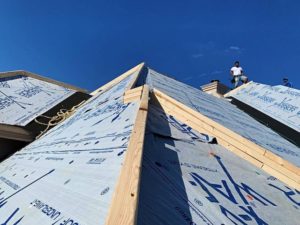 Although designs vary, the essential parts of a roof will be the same. Whether you are just curious about its construction, are in need of repairs, or think you may need a replacement roof, it can be helpful to know how your roof is constructed. Understanding your roof’s construction and some of the terminology associated with its different components will better prepare you for any problems that may arise during its lifetime and facilitate communications when you call a licensed roof contractor for assistance.
Although designs vary, the essential parts of a roof will be the same. Whether you are just curious about its construction, are in need of repairs, or think you may need a replacement roof, it can be helpful to know how your roof is constructed. Understanding your roof’s construction and some of the terminology associated with its different components will better prepare you for any problems that may arise during its lifetime and facilitate communications when you call a licensed roof contractor for assistance.
How Is a Residential Roof Typically Constructed?
Any contractor with experience roofing Austin homes can tell you that homes in Central Texas vary widely in terms of architecture, materials, and size. Typically, the roof is an integral part of the home’s overall design, so roofs range from simple to highly complex. Although not every component on the following list will be present on every home, most components will be included.
• Decking: The decking, which is also referred to as sheathing, is nailed to the outside of the rafters of the roof frame and completely covers the roof structure. Plywood and oriented strand board are two materials that are commonly used for residential roof decking. Decking creates the smooth, even surface needed for subsequent layers of roofing materials and adds structural integrity to the framework.
• Underlayment: The underlayment is placed directly on top of the decking in overlapping layers to keep moisture away from the decking. Underlayment is an asphalt felt or tar paper that comes in large rolls.
• Flashing: Flashings are metal strips and pieces that are placed around roof protrusions, including chimneys, vent pipes, and skylights, to prevent water from entering around them. Flashing is also placed at points where the roof and a wall intersect, and it may be placed inside roof valleys to catch and divert water off the roof.
• Roof Covering: For Austin residential roofing, asphalt shingles are the most popular choice. Other roofs covering types include metal, wood, and tile. Asphalt shingles are nailed down over the underlayment. Other types of roof coverings can use different methods to attach them.
• Ridge: There are two definitions for a roof’s ridge. It is a horizontal line at the peak of the roof where opposing planes meet, but it is also the boards used to build the ridge. Since the rafters are connected to the ridge, a broken ridge board can be a severe safety issue.
• Eaves: The eaves are the bottom edge of the roof. In most architectural styles, the eaves extend beyond the exterior walls.
• Fascia: Fascia boards are trim pieces that cover the ends of rafters at the eaves. Gutters are frequently attached to the fascia boards.
• Soffit: A soffit is the underside of an eave. Soffits may be exposed, enclosed, or ventilated.
• Vents: Every roof requires ventilation to remove hot, moist air from the attic. Older homes may have louver-type vents attached to the gable ends of the attic walls. A new roof is more likely to have ridge vents attached at the roof’s highest point.
• Valley: Valleys are the low spots where two roof planes meet. They play an important part in channeling runoff and may be open or enclosed.
Alpha Roofing is a full-service Austin roofer headquartered in Round Rock. From a routine inspection to a roof replacement, we can help. Our services include the installation of flashings, skylights, asphalt shingles, and metal roofs as well as chimney and roof repairs. Give us a call at 512-777-1086 to speak with one of our friendly roof experts or fill out the online form to request a free job quote.
